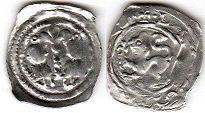Coins of Carinthia - catalog with values
Duchy of Carinthia (Kärnten)
Kreuzer=4 pfennig; Pfennig=2 heller
Bernhard (1202-1256)

pfennig no date
silver
Coin value ~ 50-70 USD
Ferdinand I (Emperor since 1558) (1521-1564)

1 pfennig 1536
silver
Coin value ~ 30-40 USD
Ferdinand II (Emperor since 1619) (1590-1637)

2 pfennig 1614
silver
Coin value ~ 20-30 USD
Costs of Carinthia coins in this catalog approximate and indicated specifically for the coin shown in the picture.
I do not buy or sell coins - this is just a catalog.

